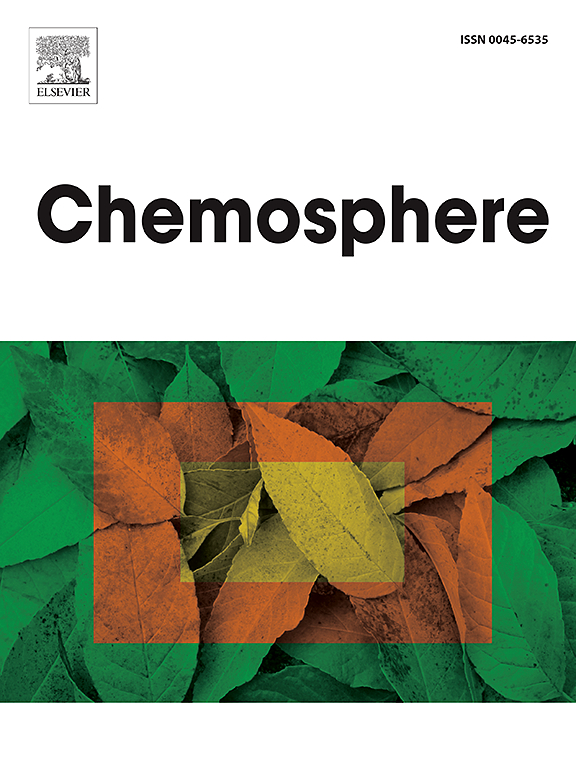双氯芬酸在平面、微结构2D和大孔3D掺杂硼金刚石电极上的高效电化学降解:降解和转化产物的鉴定。
IF 8.1
2区 环境科学与生态学
Q1 ENVIRONMENTAL SCIENCES
引用次数: 0
摘要
电化学高级氧化过程(EAOPs)高效降解持久性有机物质,且不会产生潜在有害副产物,对未来的水管理至关重要。在本研究中,采用三种形貌(平面二维、微结构二维和大孔三维)的掺硼金刚石电极(BDDE)在两种工作电解质(NaCl和Na2SO4)中阳极氧化双氯芬酸(DCF)。HPLC-HRMS共鉴定了DCF电化学氧化过程中产生的11种副产物。降解产物的鉴定表明形成了多种活性氯代物质。使用不含氯的Na2SO4电解液可以生成更多的氯化物质,但与使用NaCl电解液相比,它们的消除需要更长的时间。副产物的形成也受到特定类型的BDD电极的影响,这与施加电流密度的变化有关。这导致了二氯(2D BDDE)和三氯(3D BDDE)图案的不均匀分布。然而,没有一种产品显示出高水平持久性的迹象。结果表明,电解液类型是影响DCF去除率的最显著因素,而电极形态的不同并不会导致去除率的差异。电极类型对去除率有显著影响,这与不同的施加电流密度有关,仅在Na₂SO₄电解质的情况下。NaCl对DCF的去除率达到99%以上,能耗为1.8 kWh m-3。本文章由计算机程序翻译,如有差异,请以英文原文为准。

A high-efficient electrochemical degradation of diclofenac in water on planar and microstructured 2D, and macroporous 3D boron-doped diamond electrodes: Identification of degradation and transformation products
The highly efficient degradation of persistent organic substances by electrochemical advanced oxidation processes (EAOPs), which don't result in the formation of potentially harmful by-products, is crucial for the future of water management.
In this study, boron-doped diamond electrodes (BDDE) with three morphologies (planar 2D, microstructured 2D, and macroporous 3D) were employed for the anodic oxidation of diclofenac (DCF) in two working electrolytes (NaCl and Na2SO4). In total, 11 by-products formed during the electrochemical oxidation of DCF were identified via HPLC-HRMS. The identification of degradation products revealed the formation of various active chlorinated species. The utilization of a chlorine-free Na2SO4 electrolyte resulted in the formation of greater number of chlorinated species, while their elimination required a longer period compared to the use of NaCl electrolyte. The formation of by-products was also influenced by the specific type of BDD electrode, which was associated with variations in applied current density. This led to an uneven distribution of dichloro (2D BDDE) and trichloro (3D BDDE) patterns. However, none of the products showed signs of a high level of persistence.
The results revealed that the type of electrolyte is the most significant factor affecting the removal efficiency of DCF, while the different electrode morphologies do not lead to differences in the removal rates. The electrode type exerted a notable influence on the removal rates, which was associated with varying applied current densities, exclusively in the case of the Na₂SO₄ electrolyte. Over 99 % removal efficiency for DCF in NaCl, with power consumption of 1.8 kWh m−3 was achieved.
求助全文
通过发布文献求助,成功后即可免费获取论文全文。
去求助
来源期刊

Chemosphere
环境科学-环境科学
CiteScore
15.80
自引率
8.00%
发文量
4975
审稿时长
3.4 months
期刊介绍:
Chemosphere, being an international multidisciplinary journal, is dedicated to publishing original communications and review articles on chemicals in the environment. The scope covers a wide range of topics, including the identification, quantification, behavior, fate, toxicology, treatment, and remediation of chemicals in the bio-, hydro-, litho-, and atmosphere, ensuring the broad dissemination of research in this field.
 求助内容:
求助内容: 应助结果提醒方式:
应助结果提醒方式:


